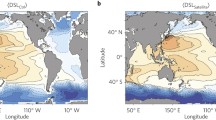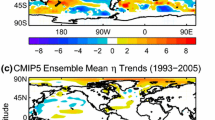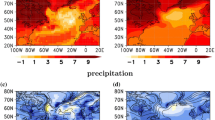Abstract
In addition to projected increases in global mean sea level over the 21st century, model simulations suggest there will also be changes in the regional distribution of sea level relative to the global mean. There is a considerable spread in the projected patterns of these changes by current models, as shown by the recent Intergovernmental Panel on Climate Change (IPCC) Fourth Assessment (AR4). This spread has not reduced from that given by the Third Assessment models. Comparison with projections by ensembles of models based on a single structure supports an earlier suggestion that models of similar formulation give more similar patterns of sea level change. Analysing an AR4 ensemble of model projections under a business-as-usual scenario shows that steric changes (associated with subsurface ocean density changes) largely dominate the sea level pattern changes. The relative importance of subsurface temperature or salinity changes in contributing to this differs from region to region and, to an extent, from model-to-model. In general, thermosteric changes give the spatial variations in the Southern Ocean, halosteric changes dominate in the Arctic and strong compensation between thermosteric and halosteric changes characterises the Atlantic. The magnitude of sea level and component changes in the Atlantic appear to be linked to the amount of Atlantic meridional overturning circulation (MOC) weakening. When the MOC weakening is substantial, the Atlantic thermosteric patterns of change arise from a dominant role of ocean advective heat flux changes.










Similar content being viewed by others
Notes
In the course of answering reviewer comments we found that for one model (GISS-ER) the difference between the global thermal expansion provided by the modelling groups, and alternatively calculated using subsurface model temperature data provided in the CMIP3 database, was sufficiently large as to give some concern about the accuracy of the steric component patterns for this model. Excluding this model from our analysis of steric components would not affect the conclusions in this paper.
If the GISS-ER model is excluded, the ensemble mean correlation between the sea level and steric component changes increases to 0.74 and the minimum correlation for the ensemble increases to 0.39.
The iap model is excluded as it has a near collapsed MOC in the latter part of its twentieth century simulation (Meehl et al. 2007 their Fig. 10.15).
References
Bindoff NL, Willebrand J, Artale V, Cazenave A, Gregory JM, Gulev S, Hanawa K, LeQuéré C, Levitus S, Nojiri Y, Shum CK, Talley LD, Unnikrishnan AS (2007) Observations: oceanic climate change and sea level. In: Solomon S, Qin D, Manning M, Chen Z, Marquis M, Averyt KB, Tignor M, Miller HL (eds) Climate change 2007: the physical science basis. Contribution of Working Group I to the Fourth Assessment Report of the Intergovernmental Panel on Climate Change, Cambridge University Press, London
Bryan K (1996) The steric component of sea level rise associated with enhanced greenhouse warming: a model study. Clim Dyn 12:545–555
Church JA, Gregory JM, Huybrechts P, Kuhn M, Lambeck K, Nhuan MT, Qin D, Woodworth PL (2001) Changes in sea level. In: Houghton JT, Ding Y, Griggs DJ, Noguer M, vander Linden P, Dai X, Maskell K, Johnson CI (eds) Climate change 2001: the scientific basis. Contribution of Working Group I to the Third Assessment Report of the Intergovernmental Panel on Climate Change, Cambridge University Press, London, pp 639–693
Gregory JM, Church JA, Boer GJ, Dixon KW, Flato GM, Jackett DR, Lowe JA, O’Farrell SP, Roeckner E, Russell GL, Stouffer RJ, Winton M (2001) Comparison of results from several AOGCMs for global and regional sea-level change 1900–2100. Clim Dyn 18:225–240
Hsieh WW, Bryan K (1996) Redistribution of sea level rise associated with enhanced greenhouse warming: a simple model study. Clim Dyn 12:535–544
Katsman CA, Hazeleger W, Drijfhout SS, van Oldenborgh GJ, Burgers G (2008) Climate scenarios of sea level rise for the northeast atlantic ocean: a study including the effects of ocean dynamics and gravity changes induced by ice melt. Clim Change 91:351–374
Köhl A, Stammer D (2008) Decadal sea level changes in the 50-year GECCO ocean synthesis. J Clim 21:1876–1890. doi:10.1175/2007JCLI2081.1
Landerer FW, Jungclaus JH, Marotzke J (2007a) Ocean bottom pressure changes lead to a decreasing length-of-day in a warming climate. Geophys Res Lett 34(L06307). doi: 10.1029/2006GL029106
Landerer FW, Jungclaus JH, Marotzke J (2007b) Regional dynamic and steric sea level change in response to the IPCC-A1B scenario. J Phys Oceanogr 37:296–312
Levermann A, Griesel A, Hofmann M, Montoya M, Rahmstorf S (2005) Dynamic sea level changes following changes in the thermohaline circulation. Clim Dyn 24:347–354. doi:10.1007/s00382-004-0505-y
Lowe JA, Gregory JM (2006) Understanding projections of sea level rise in a Hadley Centre coupled climate model. J Geophys Res p C11014. doi:10.1029/2005JC003421
Meehl GA, Stocker TF, Collins WD, Friedlingstein P, Gaye AT, Gregory JM, Kitoh A, Knutti R, Murphy JM, Noda A, Raper SCB, Watterson IG, Weaver AJ, Zhao Z (2007) Global climate projections. In: Solomon S, Qin D, Manning M, Chen Z, Marquis M, Averyt KB, Tignor M, Miller HL (eds) Climate change 2007: The Physical Science Basis. Contribution of Working Group I to the Fourth Assessment Report of the Intergovernmental Panel on Climate Change, Cambridge University Press, London
Mitrovica JX, Gomez N, Clark PU (2009) The sea-level fingerprint of West Antarctic collapse. Science 323:753
Murphy J, Booth B, Collins M, Harris G, Sexton D, Webb M (2007) A methodology for probabilistic predictions of regional climate change from perturbed physics ensembles. Philos Trans R Soc Lond 365:2133
Murphy JM, Sexton DMH, Barnett DN, Jones GS, Webb MJ, Collins M, Stainforth DA (2004) Quantification of modelling uncertainties in a large ensemble of climate change simulations. Nature 430:768–772
Nicholls RJ, Carter TR, Warrick RA, Lowe JA, Lu X, O’Neill BC, Hanson SE, Long AJ (2009) Guidelines on constructing sea level scenarios for impact and vulnerability assessment of coastal areas. supporting material, Intergovernmental Panel on Climate Change Task Group on data and scenario support for Impact and Climate Analysis (TGICA) (in review)
Pardaens A, Vellinga M, Wu P, Ingleby B (2008) Large-scale Atlantic salinity changes over the last half-century: a model-observation comparison. J Clim 21:1698–1720. doi:10.1175/2007JCLI1988.1
Russell GL, Gornitz V, Miller JR (2000) Regional sea-level changes projected by the NASA/GISS atmosphere-ocean model. Clim Dyn 16:789–797
Russell JL, Dixon KW, Gnanadesikan A, Stouffer RJ, Toggweiler JR (2006) The southern hemisphere westerlies in a warming world: propping open the door to the deep ocean. J Clim 19:6382–6390
Sato Y, Yukimoto S, Tsujino H, Ishizaki H, Noda A (2006) Response of North Pacific ocean circulation in a Kuroshio-resolving ocean model to an Arctic Oscillation (AO)-like change in northern hemisphere atmospheric circulation due to greenhouse-gas forcing. J Meteorol Soc Jpn 84(2):295–309
Suzuki T, Hasumi H, Sakamoto TT, Nishimura T, Abe-Ouchi A, Segawa T, Okada N, Oka A, Emori S (2005) Projection of future sea level and its variability in a high-resolution climate model: ocean processes and greenland and antarctic ice-melt contributions. Geophys Res Lett 32. doi:10.1029/2005GL023677
Vellinga M, Wood RA (2007) Impacts of thermohaline circulation shutdown in the twenty-first century. Clim Change. doi:10.1007/s10584-006-9146-y
Yin J, Schlesinger ME, Stouffer RJ (2009) Model projections of rapid sea-level rise on the northeast coast of the United States. Nat Geosci 2:262–266. doi:10.1038/ngeo462
Acknowledgments
This work was supported by the Joint DECC and Defra Integrated Climate Programme—DECC/Defra (GA01101). The multi-model dataset used for the AR4 analysis was archived by the World Climate Research Programme’s (WCRP’s) Coupled Model Intercomparison Project phase 3 (CMIP3). We acknowledge the international modelling groups for providing their data for analysis. We thank Mat Collins and the Met Office QUMP team for providing the two QUMP ensembles analysed in this study. We thank Michael Vellinga and Chris Brierley for access to the non-fluxadjusted QUMP coupled model ensembles referred to. We also thank the reviewers for their useful comments and suggestions.
Author information
Authors and Affiliations
Corresponding author
Additional information
An erratum to this article can be found at http://dx.doi.org/10.1007/s00382-010-0817-z
Electronic supplementary material
Below is the link to the electronic supplementary material.
Rights and permissions
About this article
Cite this article
Pardaens, A.K., Gregory, J.M. & Lowe, J.A. A model study of factors influencing projected changes in regional sea level over the twenty-first century. Clim Dyn 36, 2015–2033 (2011). https://doi.org/10.1007/s00382-009-0738-x
Received:
Accepted:
Published:
Issue Date:
DOI: https://doi.org/10.1007/s00382-009-0738-x




